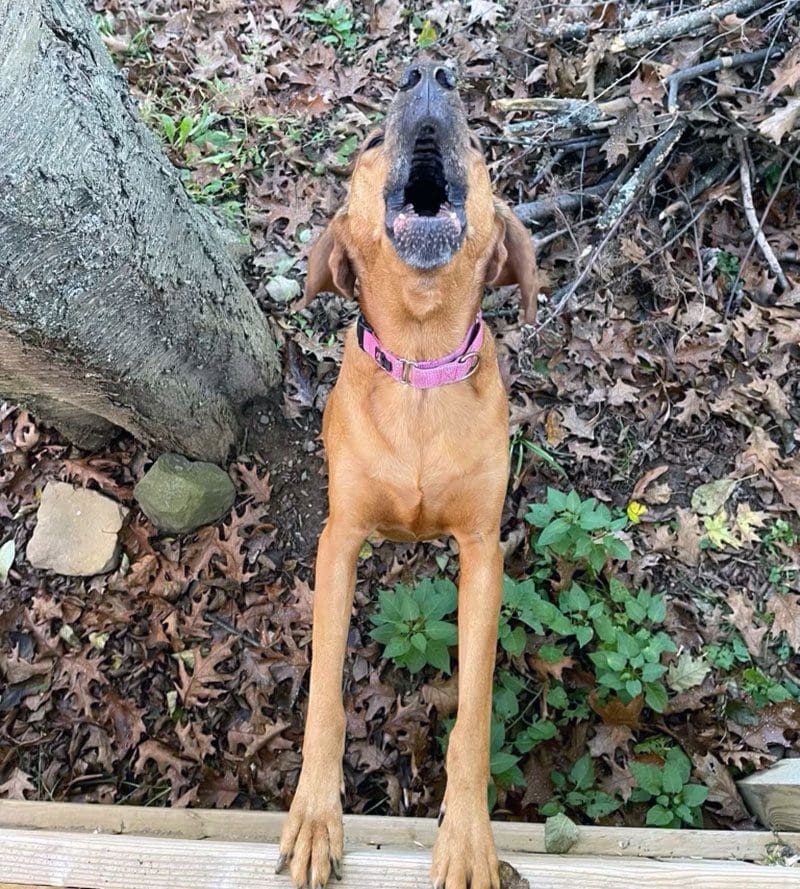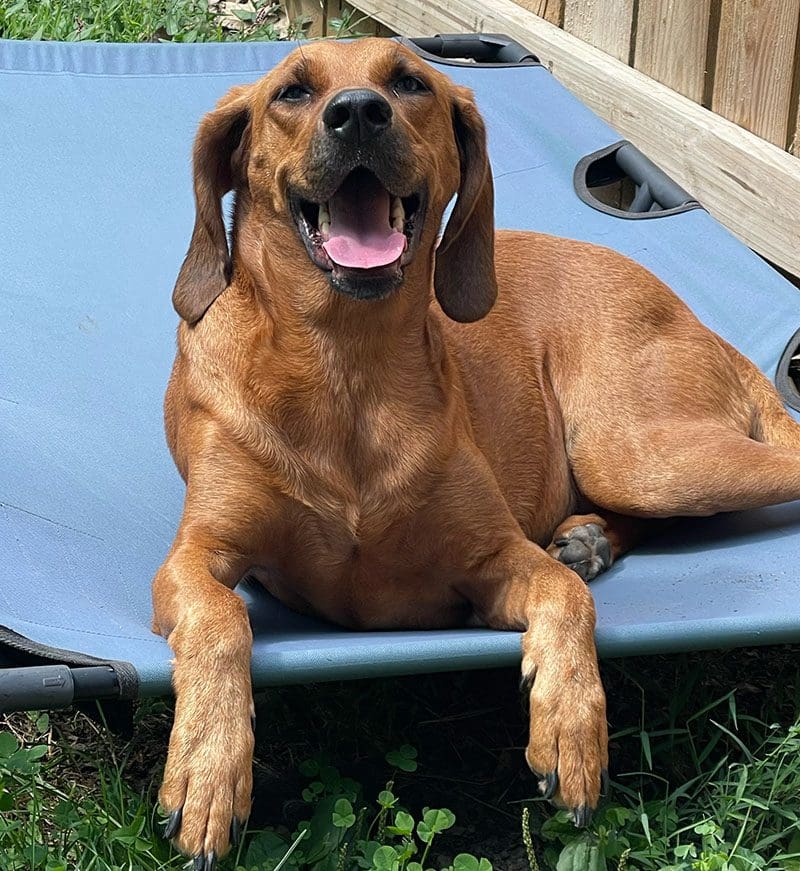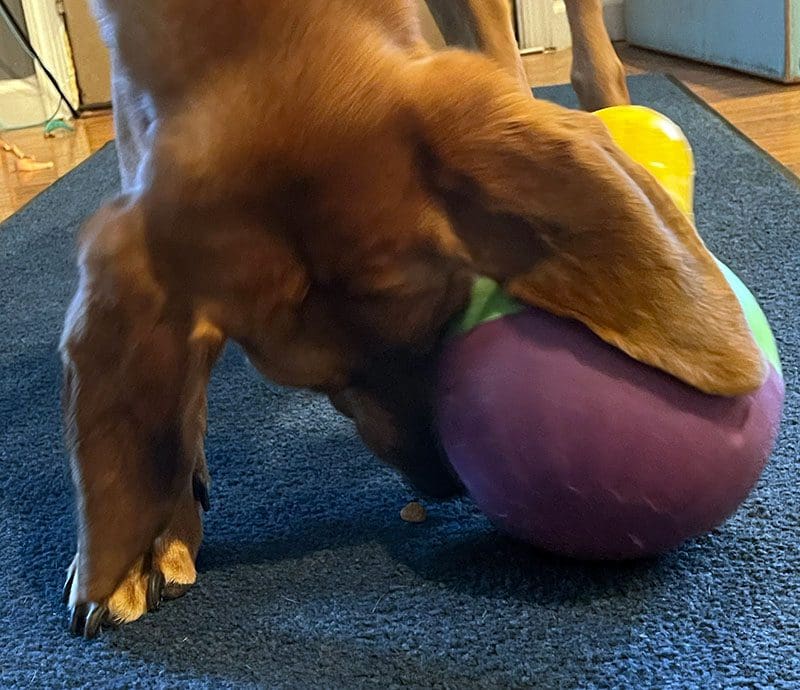
Does your dog suffer from panic attacks, anxiety, hyperactivity, excessive panting, or other behavioral issues?
As a professional dog groomer, I am frequently asked how to calm a dog down. In order to help with that, I wrote this article so that you can find healthy ways to calm your dog down.
Unwanted behavior is one of the most common reasons for dogs to be given up to shelters.
The good news is that there are several quality products and strategies for a variety of situations. Please read on to learn more about some of the most helpful calming aids for dogs that I’ve found over the years.
In this Article We Cover:
- What Causes Dog Panic Attacks, Anxiety, Panting, and Other Behavioral Issues?
- How to Calm a Dog Down: Products and Tips
- Why is My Dog Panting?
- Does Neutering Calm a Dog Down?
- A Calm Conclusion

What Causes Dog Panic Attacks, Anxiety, Panting, and Other Behavioral Issues?
In order to learn how to calm a dog down, it’s good to know what causes dog behavior problems in the first place.
As a dog groomer and behavior consultant, I find that many people are surprised to learn that teaching your dog to cope with stress should not include any punitive methods.
Dog punishment products such as choke chains, prong collars, and shock collars should NOT be used and will only add to your dog’s stress.
If your dog is barking excessively, and you purchase an anti-bark collar that spritzes him in the nose with citronella, you are not solving the reason behind his excessive barking.
Additionally, you are punishing your dog for displaying a natural behavior that he’s using as an outlet to satisfy a need that isn’t met. You are adding to his stress and introducing a new, unnatural effect in his environment that robs him of a necessary behavior.
It is more effective and kinder to address the cause of your dog’s behavior, rather than punish the symptoms.
Dog Anxiety and Stress Can Cause the Following Behaviors:
When dogs have anxiety and stress, they can exhibit a range of undesirable behavior such as:
- Reactivity (Dog Panic Attacks)
- Excessive Panting
- Inappropriate Biting
- Issues Around Children
- Issues with Other Pets
- General Aggression and Hyperactivity
So what causes dog anxiety and stress? Well, two of the most common causes are medical issues and the dog’s environment.
Dog Anxiety and Stress from Medical Issues
When looking for ways to calm a dog down, the first step is to have your dog evaluated by a vet to make sure there aren’t any medical concerns that could be causing the issues.
Many dogs chew or lick their legs and feet out of anxiety. However, arthritis and other pain issues such as allergies, irritation, and even a toenail fungus found in dogs can be the cause of excessive licking and chewing of the limbs, paws, and pads of the foot.
If your dog is fearful or anxious in specific circumstances, like when he’s at the vet, groomer, or during storms or fireworks, you can also talk to your vet about possibly adding anti-anxiety medication to help your dog cope during these times.
Properly prescribed anti-anxiety medications can help take the edge off of your dog’s fear. This can also put your dog in a better headspace for learning to cope with these events in the future.

Dog Anxiety and Stress from the Environment
If you book a session with a qualified force-free trainer or behavior consultant, they can evaluate your dog and make very specific recommendations for your dog’s behavioral issues.
It can also be very helpful to set up your dog’s environment and routines to promote a low-stress lifestyle, and provide healthy outlets for excessive or nervous energy.
When something stressful or exciting happens in your dog’s environment, training and socialization using a gradual, gentle, reward-based technique will prepare him to act appropriately.
Your dog’s environment doesn’t begin and end at home. We also need to consider when he needs to go out into the world, such as a trip to the vet or groomer, or even just on a walk for his usual exercise.
Please keep reading and I will share some of my favorite tools, treats, and tricks of the trade to reduce stress and anxiety for both you and your dog.
How to Calm a Dog Down: Products and Tips

My clients will often ask me what products I buy for my own pets. I signed up for the Amazon Associate Program so that I can include Amazon product links in this article.
If you click on a link below and make a purchase, I will receive a small commission at no extra cost to you. I truly appreciate this as it helps me to continue my mission to provide pet wellness education. Thank you so much!
The Art of Dog Calming
There are some great products available that are designed to help take the edge off of dog anxiety and stress.
Since dog anxiety and stress is often at the root of many dog behavior issues, you can definitely help both you and your dog by introducing some of these products into your dog’s home environment.
Dog Calming Treats
Calming supplements, such as Doug’s Reserve Calming Dog Treats may be helpful for dogs who seem to have trouble settling before or after the day’s activities.
I always carry tasty treats with me wherever I go with my dogs. Some of my favorites are Stewart Bacon Pop-Its Dog Treats as well as other products offered by Stewart.
I like to carry a ziplock bag full of these tasty dried treats. I’ll break them into smaller pieces when I need a ready source of comfort or reward for my dogs.
When something really scary or distracting happens, I might offer them a larger portion or a big jack pot pile.
For winding down time, or for a distraction during storms, a slow-burn kind of treat is what I look for.
How to Calm a Dog During Fireworks
Many dogs enjoy puzzles. My dog Lucy absolutely loves them. For dogs like Lucy, I recommend toys that drop treats when they are manipulated, such as StarMark Bob-A-Lot Interactive Dog Toy.

If your dog needs strong motivation to ignore a stressful event, such as fireworks, consider loading an interactive dog toy with pieces of hot dog.
You can freeze or dehydrate the hot dog pieces to limit the mess. You can also include less special food, such as their kibbles and small pieces of carrot.
The lottery type treat delivery actually increases the dog’s incentive to keep playing – just like humans in Vegas!
Dogs who are less fond of puzzles might like some peanut butter or cream cheese smeared on a Lickimat Tuff. You can offer it just like that, or place it in the freezer to help it last a bit longer.
Chewing, licking, and eating are all stress relieving activities for dogs.
Fear is an emotion and not a behavior. So, you can go right ahead and comfort your dog during scary events. I’ve had thunder and firework fearful dogs who felt safest squashed behind me on the couch.
A Thundershirt Classic for Dogs can also provide your dog with a little extra security.
How to Calm a Dog with Crate Training
- Amazon Basics Portable Folding Soft Dog Travel Crate
- iCalmDog Bluetooth Speaker
- JOEJOY Large Dog Bed Crate Pad
- ThunderEase Dog Calming Pheromone Spray
Crate Training can provide your dog with a quiet place to retreat from the rest of the household. It’s important to know that you don’t need to close the crate door. If you make the crate cozy and inviting for your dog, he will happily spend time taking a break there.
Something like the Amazon Basics Portable Folding Soft Dog Travel Crate can provide your dog with his own “decompression room”. He can retreat there when he’s feeling overwhelmed. Everyone, including children, should see your dog’s crate as a no-go zone.
You can place the iCalmDog Bluetooth Speaker nearby to help drown out stressful noise. A soft mat placed in the bottom of the crate can make the space more inviting. The JOEJOY Large Dog Bed Crate Pad would work very well for this.
I like to use ThunderEase Dog Calming Pheromone Spray in the grooming shop. I also use it in the car to provide a sense of calm to my own dogs. You can use it to mist the inside of your dog’s crate too!

How to Keep Your Dog Calm and Stay in Control Outside the Home
- AOKLANT Dog Leash
- PetSafe Nylon Dog Leash
- Blue-9 Buckle-Neck Balance Harness
- Max and Neo Nylon Martingale Collar
- Lynxking Check Cord Dog Leash
- PupFlask Large Dog Water Bottle
I use a 6’ leash on my dogs whenever I take them to appointments. I will only use retractable leashes with my dogs for exercise in open areas or going to the bathroom.
The AOKLANT Dog Leash is wonderful because it is leather and comfortable to hold. It works great even if your dog is prone to pulling on the leash.
For small dogs I like the 3/8th of an inch wide PetSafe Nylon Dog Leash for small dogs.
You should always carry small dogs into areas where they might be frightened or stressed. I use the leash just as a backup in case they jump down. In most cases, carrying is the best method to keep a small, scared dog safe.
A simple, 6’ leash is the easiest way for you to hand your dog off to the vet or technician. Keep interactions with other people short. If you’re going into the vet’s office or groomer’s shop, make sure you don’t linger in the doorway.
Holding open the door when your pet has escape on his mind makes my hair stand on end!
If your dog is stressed while at the vet, groomer, or a busy park, just take a moment to let him process the environment, preferably from a distance. This will give your dog a chance to calm down.
Dogs Prefer Harnesses Over Collars
The Blue-9 Buckle-Neck Balance Harness is a great harness as it’s fully customizable and doesn’t inhibit shoulder movement.
In general, you don’t want to walk your dog on a collar as it can cause damage to his sensitive neck and throat.
However, if you are concerned about your dog escaping, then you should try using a harness in combination with the Max and Neo Nylon Martingale Collar.
This can provide you with an extra level of security if your dog is prone to escape.
The design of the collar will keep it from slipping over your dog’s head. When adjusted properly, it won’t tighten to the point of choking.
First, you attach the leash to the harness. Next you clip a second, short tether to the end of the main leash and then over to the collar.
This means the collar will only come into play if the dog happens to slip the harness. However, this shouldn’t happen if the equipment is of good quality and adjusted properly.
Playing the Long Leash Game

Next, for fulfilling outside “sniffy adventures”, I use a long leash, or check cord, like the Lynxking Check Cord Dog Leash. To prevent rope burn, I wear a pair of flexible leather work gloves.
Until you’re practiced at letting the line in and out to prevent tangling, a 15 or 30’ cord might be easier to manage than the 50’ cord.
With my pockets full of treats, and a PupFlask Large Dog Water Bottle full of water, I find an open field to let my dogs be dogs.
You want to keep a comfortable pace and allow your dog to lope at their own natural speed.
This allows your dog to stop and sniff, and run some more, and then stop and pee, and start moving again, and then stop and sniff something new, and then bork a bit.
Your dog can go on and on like this to his heart’s content.
Cooperative Care: A Great Book on How to Calm a Dog
A book I like to recommend to my clients is “Cooperative Care: The Seven Steps to Stress Free Husbandry” by Deb Jones.
Cooperation requires that the dog is not being coerced or forced into situations where they don’t feel they are safe.
All training, even basic obedience, should start in your home where your dog is likely to feel the safest and the least distracted.
As your dog becomes more proficient at the behaviors you’re teaching you can move to a slightly more distracting environment.
Why is My Dog Panting?
I’ve had grooming clients bring me dogs to be shaved down because the dogs were panting a lot. They thought this was due to the dogs being hot.
After evaluations from the veterinarian, it was determined the dogs had medical issues. Some of them were suffering from arthritis pain and others were very suffering from high levels of anxiety.
Excessive panting in dogs could be due to something other than just the dog trying to cool themselves. It’s best to bring this to the attention of a vet.
Keep an eye out for anything else that seems abnormal and let the vet know about that as well.
Does Neutering Calm a Dog Down?
You might be wondering does neutering calm a dog down? Or, will spaying calm a female dog?
The answer is: If your dog’s behavior is related to sex hormones, then neutering can calm them down.
Spaying is the term used for female dogs, and it is more involved than castrating a male dog.
“Neuter” can refer to the procedure done on a male or female.
Spaying and Neutering can be the answer if your dog is old enough.
If your dog’s energy or inappropriate behavior is related to sex hormones, then having them altered would eliminate that issue, along with several types of cancer and a dangerous infection that female dogs can get in their uterus.
Spaying and neutering after a health issue develops can be costly and dangerous, so it’s best to have these surgeries done when your vet feels that your dog is old enough and ready for the procedure.
Calming a dog who humps constantly or is sexually excited can be difficult. This can lead to other unwanted behaviors that stem from constant frustration.
This is where redirection can be helpful. Interrupting the behavior and directing it to another healthy outlet might do the trick if you’re consistent.
Dogs who are humping inappropriately can be more likely to be aggressive. They do this in order to guard the object of their attention.
If your vet deems your dog to be healthy and old enough for the procedure, then I am a strong advocate for spaying and neutering dogs for a multitude of reasons – unwanted litters and pet over-population aside.
A Calm Conclusion

It’s important to remember that teaching your dog to cope with stress should not include any punitive methods. Dog punishment products such as choke chains, prong collars, and shock collars should NOT be used and will only add to your dog’s stress.
If your dog is displaying signs of anxiety and stress, the first two areas to explore are medical issues and the dog’s environment.
When looking for ways to calm a dog down, the first step is to have your dog evaluated by a vet to make sure there aren’t any medical concerns that could be causing the issues.
If you book a session with a qualified force-free trainer or behavior consultant, they can evaluate your dog and make very specific recommendations for your dog’s behavioral issues.
It can also be very helpful to set up your dog’s environment and routines to promote a low-stress lifestyle, and provide healthy outlets for excessive or nervous energy.
Thank you for reading this article and I wish you and your dog many enjoyable adventures ahead!
Ready for More Dog Articles?
Please check out our Dog Blog for a full listing of all of our dog articles!
Join Our Mailing List!
We hope you enjoyed reading this article! The Absolute Animal Care Blog features articles that contain our best recommendations for dog and cat wellness, training strategies, and products.
Please join our mailing list to receive updates when new articles are released!
Photo of Corgi Dog by fatty corgi
German Shepherd Dog Photo by Kinshuk Bose
Dog Holding Flower Photo by Richard Brutyo
All Other Dog Photos by Absolute Animal Care
